油火检探头说明书
汽油站和地下燃料存储设备监测的钢铁磁性内墙探头说明书
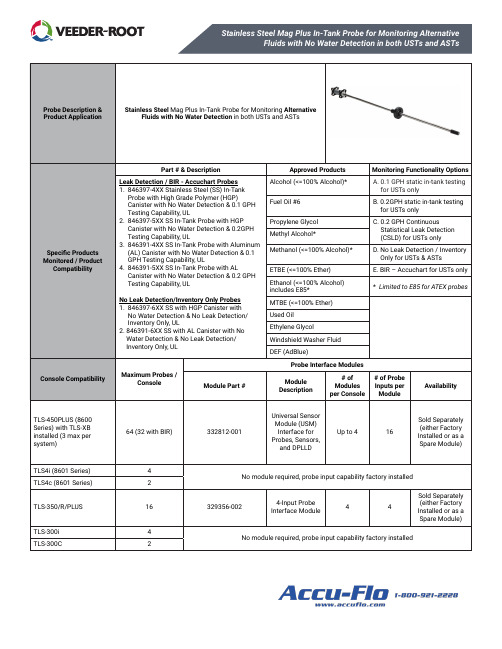
Approved Products Monitoring Functionality Options Alcohol (<=100% Alcohol)* A. 0.1 GPH static in-tank testingfor USTs onlyB. 0.2GPH static in-tank testingfor USTs onlyC. 0.2 GPH ContinuousStatistical Leak Detection 1.888.561.7942125 Powder Forest Drive • PO Box 2003 • Simsbury, CT 06070 • ©2019 Veeder-Root • P/N 577014-449-08 Rev. AAll information contained in this document is subject to change without notice.NoticeVeeder-Root makes no warranty of any kind with regard to this publication, including, but not limited to, the implied warranties of merchantability and fitness for a particular purpose.Veeder-Root shall not be liable for errors contained herein or for incidental or consequential damages in connection with the furnishing, performance, or use of this publication.Veeder-Root reserves the right to change system options or features, or the information contained in this publication.This publication contains proprietary information which is protected by copyright. All rights reserved. No part of this publication may be photocopied, reproduced, or translated to another language without the prior written consent of Veeder-Root.Example IllustrationsIllustrations used in this guide for example sensor installations may contain components that are customer supplied and not included with the sensor. Please check with your Veeder-Root Distributor for recommended installation accessories.Third Party EvaluationsThird party evaluations of the Veeder-Root sensors contained in this application guide can be found under the Veeder-Root vendor name on the National Work Group on Leak Detection Evaluations (NWGLDE) website: ©2019 Veeder-Root. All rights reserved.。
火焰探测器手册

隔爆型红外火焰探测器(IR3)安装使用说明书(Ver.1.0, 2008.04)一、概述JTGB-HW-BK51Ex/IR3隔爆型红外火焰探测器(以下简称探测器)根据GB3836.1-2000 《爆炸性气体环境用电气设备第1部分: 通用要求》,GB3836.2-2000《爆炸性环境用防爆电气设备隔爆型电气设备“d”》和GB4208-93《外壳防护等级IP代码》的规定制成防爆外壳,其防爆标志为ExdⅡCT6,适用于工厂,温度组别为T1~T6组,出现或可能出现的爆炸危险场所作为火灾探测之用。
1.1 产品特点※三重红外IR3光谱检测※防爆、防尘等级高※远距离探测※ 90度宽锥形区域侦测※实时自诊断功能※电磁辐射免疫※专利、工业化外形设计※灵敏度可调※标准4-20mA电流输出、标准RS-485接口、无源接点输出1.2 主要用途及适用范围适用于一般工业与民用建筑中火灾萌发时无阴燃阶段,突然起火的场所。
具体应用如下:化学品 --- 生产、储存、运输发电 --- 泵区、机房、无人职守区炸药和军需品 --- 储存和装卸印刷 --- 溶剂处理、压平、和干燥工艺飞机库汽车 --- 制造、喷漆房油漆 --- 制造仓库 --- 易燃品的储存石化产品 ---生产、储存、运输制药业石油天然气 --- 勘探、生产、储存海上石油平台沿海 --- 精练厂、冲装站、管道油库 ---浮动固定顶槽油库区废品处理厂 --- 易燃品加工、焚烧和储存1.3 使用环境条件a.海拔不超过1500m;b.周围环境温度-10℃~+55℃;c.周围空气相对湿度不大于95%(40±2℃);d.出现或可能出现的爆炸危险场所作为火灾探测之用;e. 无显著摇动和剧烈冲击振动的地方。
二、结构特征与工作原理2.1 外型结构图 2.1.12.2 内部结构第 3 页共 10 页图 2.2.12.3 工作原理IR3红外火焰探测器采用了三个对红外线敏感的红外传感器,对特定范围内的火灾红外辐射波长进行侦测。
火焰探头FL4000H中文使用说明书
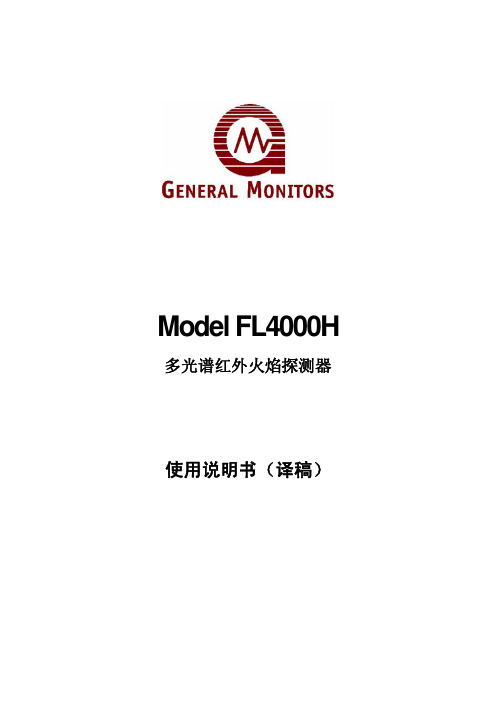
Model FL4000H 多光谱红外火焰探测器使用说明书(译稿)FL4000H目录图目录 (III)表目录 (IV)快速指导 (1)探测器的组装与接线 (1)给探测器通电 (3)用测试灯测试探测器 (3)关于此手册 (3)通用符号 (4)其它帮助信息 (4)1.0 安装前准备 (5)1.1系统完整性检验 (5)1.2安全系统的试运行 (5)1.3特别警告 (5)1.4术语表 (6)2.0 产品总观 (8)2.1总述 (8)2.2性能与优点 (8)2.3应用 (9)2.4运行原理 (9)3.0安装 (15)3.1仪表的拆封 (15)3.2所需工具 (15)3.3探测器安装地点指南 (16)3.4现场接线步骤 (19)3.5探测器的安装 (19)3.6端子连接 (21)3.7拨扭开关可选设置 (28)3.8FL4000H的供电 (29)3.9测试线和继电器复位线的接地 (29)4.0 MODBUS 界面 (30)4.1介绍 (30)4.2通信从机地址 (30)4.3波特率 (30)4.4数据格式 (30)4.5支持的功能代码 (31)4.6MODBUS读状态协议(查询/响应) (31)4.7MODBUS写指令协议(查询/响应) (32)4.8异常响应和异常代码 (32)4.9指令寄存器地址 (33)4.10命令寄存器细则 (37)5.0 保养与维修 (51)5.1日常保养 (51)5.2清洗蓝宝石窗口 (51)5.3灵敏度核对 (52)5.4存贮 (52)6.0 故障分析 (53)6.1故障分析表 (53)6.2总装 (53)7.0 客户支持 (55)7.1GM公司办事处 (55)7.2其它帮助信息 (55)8.0 附录 (56)8.1担保 (56)8.2技术参数 (56)8.3管理机构认证 (58)8.4对误报警源的响应 (59)8.5备件和附件 (60)9.0 附录A (63)图目录图1:FL4000H壳体 (1)图2:安装说明 (2)图3:壁装 (2)图4:支架组件 (2)图5:现场接线端子用于火灾报警系统接线图 (3)图6:FL4000H前视图 (8)图7:测试灯闪烁选项 (13)图8:测试线接地或MODBUS命令选项 (14)图9:水平视角-正庚烷-高灵敏度 (16)图10:水平视角-正庚烷-中灵敏度 (17)图11:水平视角-正庚烷-低灵敏度 (17)图12:垂直视角-正庚烷-高灵敏度 (17)图13:垂直视角-正庚烷-中灵敏度 (18)图14:垂直视角-正庚烷-低灵敏度 (18)图15:FL4000H壳体 (19)图16:探测器的安装 (20)图17:仪表尺寸图 (21)图18:剥线长度 (21)图19:探测器的壳体底座和端子板 (22)图20:端子连接 (23)图21:继电器触点保护电路 (24)图22:接线图-复位继电器、测试模式、报警测试 (26)图23:拨扭开关的位置 (28)图24:命令寄存器 (40)图25:光学器件的清洗 (52)图26:FL4000H截面图 (54)图27:TL105测试灯下面的功能板 (63)表目录表1:术语表 (7)表2:工业应用例子 (9)表3:不同运行情况下发光二极管的闪光顺序 (10)表4:所需工具 (15)表5:高灵敏度区所能覆盖的最大视角 (16)表6:正庚烷的灵敏度设定 (18)表7:端子板的连接 (22)表8:报警继电器端子 (23)表9:预报警继电器端子 (24)表10:故障继电器端子 (24)表11:报警复位端子 (25)表12:测试模式端子 (25)表13:报警测试端子 (25)表14:模拟输出端子 (26)表15:模拟输出电流 (26)表16:输入阻抗250Ω时的最大电缆长度 (27)表17:电源端子 (27)表18:适用于+24VDC的最长电缆长度 (27)表19:MODBUS端子 (27)表20:机架接地端 (28)表21::拨扭开关位置选项 (29)表22:可选择的波特率 (30)表23:可选择的数据格式 (31)表24:MODBUS读寄存器请求 (31)表25:MODBUS读寄存器响应 (32)表26:MODBUS写寄存器请求 (32)表27:MODBUS写寄存器响应 (32)表28:异常响应 (33)表29:异常代码 (33)表30:命令寄存器地址 (37)表31:状态模式值 (38)表32:MODBUS错误编码 (38)表33:指令1波特率 (41)表34:可选择的数据格式 (42)表35:事件记录时间格式 (47)表36:故障分析表 (53)表37:GM办事处 (55)表38:高灵敏度设置时的抗误报警能力 (59)表39:在有误报警源的情况下,探测器对火焰的响应(高灵敏度) (60)表40:备件表 (60)表41:探测器测验模式启动或用测试灯触发探测器报警 (64)快速指导探测器的组装与接线要特别注意导管密封入口(加拿大电气规范手册第一部分 18-154 节)。
油田勘探设备使用说明书
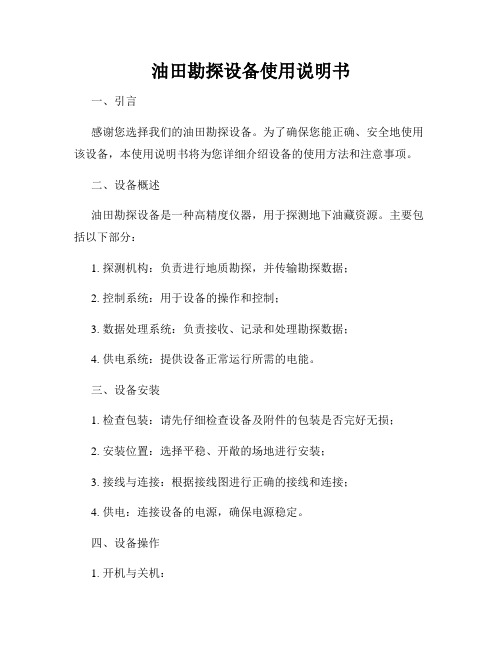
油田勘探设备使用说明书一、引言感谢您选择我们的油田勘探设备。
为了确保您能正确、安全地使用该设备,本使用说明书将为您详细介绍设备的使用方法和注意事项。
二、设备概述油田勘探设备是一种高精度仪器,用于探测地下油藏资源。
主要包括以下部分:1. 探测机构:负责进行地质勘探,并传输勘探数据;2. 控制系统:用于设备的操作和控制;3. 数据处理系统:负责接收、记录和处理勘探数据;4. 供电系统:提供设备正常运行所需的电能。
三、设备安装1. 检查包装:请先仔细检查设备及附件的包装是否完好无损;2. 安装位置:选择平稳、开敞的场地进行安装;3. 接线与连接:根据接线图进行正确的接线和连接;4. 供电:连接设备的电源,确保电源稳定。
四、设备操作1. 开机与关机:- 开机前,请确保设备处于正常状态,确保所有连接线均已连接;- 按下开机按钮,等待设备启动并完成自检;- 当设备不再使用时,请先关闭所有操作和控制面板上的开关,然后再切断电源。
2. 设备调试:- 设备开机后,进入调试模式;- 根据需要,选择合适的调试参数,如信号延时等;- 检查调试结果,确保设备正常工作。
3. 数据采集:- 根据工作要求,设置合适的数据采集参数;- 启动数据采集功能,设备将自动记录数据;- 数据采集过程中,请确保设备处于稳定的操作状态。
五、设备维护1. 清洁与防护:- 设备应定期进行清洁,防止灰尘和杂质积累;- 在停用设备时,请使用专用防尘罩进行覆盖,防止灰尘侵入。
2. 保养与维修:- 定期检查设备各部件的工作状态,如探测机构、控制系统等;- 如发现异常或故障,请联系专业人员进行修理和维护;- 请勿私自拆卸设备,以免导致更严重的问题。
六、安全注意事项1. 请确保在操作设备前经过相关培训并具备相应的操作技能;2. 在操作过程中,请严格按照设备说明书进行操作;3. 严禁在设备工作状态下随意触摸、拔插相关线缆;4. 在工作过程中如发现异常情况,请立即停机并与维修人员联系。
火焰探测器安装使用说明书
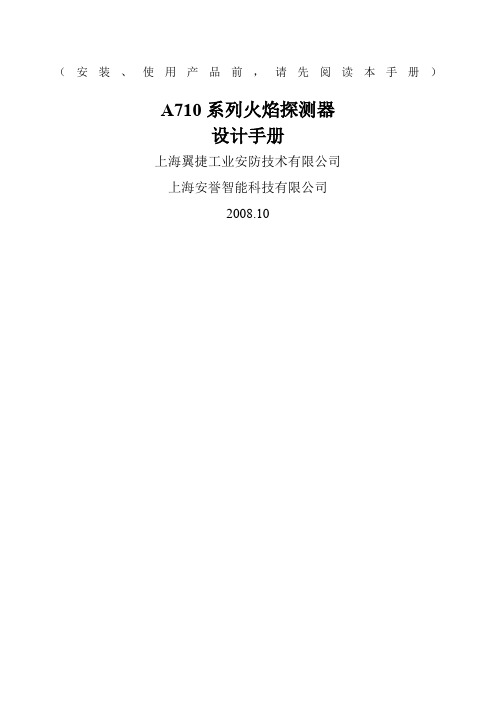
(安装、使用产品前,请先阅读本手册)A710系列火焰探测器设计手册上海翼捷工业安防技术有限公司上海安誉智能科技有限公司2008.10一、工作原理1.火焰特征1.1火焰辐射特征火焰燃烧过程释放出紫外线、可见光、红外线,其中红外部分可分为近红外、中红外、远红外三部分。
阳光、电灯、发热物体等均有热辐射,其辐射光谱随物体不同而不同,辐射光谱可能包括紫外线、红外线、可见光等1.2光谱如上图所示,自然界中按不同范围的波长分为紫外部分和红外部分,燃烧物体对应其不同波长的光谱,发出不同程度的辐射。
1.3火焰闪烁特征火焰的闪烁频率为0.5Hz – 20Hz热物体、电灯等辐射出的紫外线、红外线没有闪烁特征2.探测器工作原理2.1紫外火焰探测器2.1.1基本原理通过检测火焰辐射出的紫外线来识别火灾2.1.2紫外光谱0.18um-0.4um(180nm-400nm)太阳光中小于300nm的紫外线基本被大气层全部吸收,到达地球表面的紫外线都大于300nm2.1.3紫外探测的优缺点优点:反应速度快缺点:易受干扰2.1.4紫外火焰探测原理选用180nm-260nm的紫外传感器,对日光中的紫外线不敏感2.2双波段红外火焰探测器2.2.1基本原理通过检测火焰辐射出的红外线来识别火灾2.2.2红外光谱红外线按照波长分为近红外、中红外、远红外空气中的气体(如CO、CO2等)对特定波长的红外线具有强烈的吸收作用2.2.3双波段红外火焰探测原理选用两个波长的热释电红外传感器,来检测火焰辐射的红外线一个波长的热释电红外传感器用于检测含碳物质燃烧释放CO2引起的特定波长红外光谱的变化;一个波长的热释电传感器用于检测红外辐射的能量。
两个不同波长的传感器向结合,有效区分发热体而非火焰释放的红外线,避免误报警。
2.3三波段红外火焰探测器2.3.1基本原理通过检测火焰辐射出的红外线来识别火灾。
2.3.2红外光谱红外线按照波长分为近红外、中红外、远红外。
石油勘探仪器使用说明书

石油勘探仪器使用说明书使用说明书石油勘探仪器使用说明书引言本使用说明书适用于石油勘探仪器的操作和维护。
为了确保仪器的正常运作和长期使用,建议用户在使用前仔细阅读该使用说明书并按照指导进行操作。
本说明书将包括仪器的基本介绍、技术参数、使用步骤、故障排除以及注意事项等内容。
1. 仪器概述1.1 仪器简介石油勘探仪器是一种专门用于地下石油资源的探测和勘探的设备。
它利用电磁波的传播和反射特性,通过测量电磁波在地下的传播时间和振幅变化,确定石油资源的存在和位置。
1.2 技术参数- 电磁波频率范围: 100 Hz - 100 kHz- 探测深度范围: 100 m - 3000 m- 测量精度: ±1%- 供电电源: AC 220V, 50Hz- 功耗: 500 W2. 使用步骤2.1 准备工作在使用石油勘探仪器前,请确保以下准备工作已完成:- 确保工作环境符合仪器的使用要求,无明火和其他干扰源。
- 检查仪器的供电电源,并保证可稳定供电。
- 检查仪器的电磁波发射器和接收器是否连接稳固,无松动。
2.2 步骤一:仪器开机按下仪器面板上的电源开关按钮,仪器将开始自检程序。
正常情况下,仪器将在数秒钟内完成自检并进入运行模式。
2.3 步骤二:设置参数通过仪器面板上的菜单按钮和旋钮,用户可以设置石油勘探的参数,如频率范围、探测深度等。
请根据实际需求进行设置。
2.4 步骤三:测量操作将仪器的探测探头放置于地面,并确保与地面接触牢固。
按下测量按钮,仪器将开始发射电磁波并接收反射信号。
测量过程中,用户可以实时监测测量结果。
2.5 步骤四:数据记录与分析仪器将自动记录测量结果,并保存在内部存储器中。
用户可以通过连接仪器到计算机,并使用附带的数据分析软件进行数据导出和进一步分析。
3. 故障排除与维护3.1 故障排除在使用石油勘探仪器过程中,可能会遇到一些常见的故障。
以下是一些常见问题的可能解决方案:- 问题:仪器无法开机。
ZHJZ-IV火焰检测系统用户手册[中文A]精华版
![ZHJZ-IV火焰检测系统用户手册[中文A]精华版](https://img.taocdn.com/s3/m/786fc042a8956bec0975e392.png)
2 火焰检测原理
油 煤或气体燃料的燃烧其实质是燃料化学能以电磁波的形式释放 燃烧器火焰一 般都能发射几乎连续的发光光谱 其发射源是燃烧过程中生成的高温炭素微粒子 微粉 炭粒子群和气体等 不同的燃料燃烧过程中的中间产物不完全相同或中间产物的所占比 例各不相同 不同的燃烧中间产物所发射的光谱不完全一样 这是选择不同类型火焰检 测器依据 C2 发射可见光 发射波长为 473.7 纳米左右 CH 化合物发射紫外到蓝光区 波段的光谱 炭素粒子群发射红光区光谱 CO2 H2O 和 SO2 等三原子气体发射红外光 不同燃料的光谱分布特性是油火焰含有大量的红外线 部分可见光 和少量紫外线 煤 粉火焰含有少量紫外线 丰富的可见光和少量红外线 气体火焰有丰富的紫外线 红外 线和较少的可见光 而且对于单只燃烧器火焰 其辐射光谱沿火焰轴线分布是有规律的 例如煤粉锅炉中煤粉燃烧器沿轴线从里至外分为 4 个区域即预热区 初始燃烧区 安全 燃烧区和燃尽区 在初始燃烧区不但可见光较丰富而且能量辐射率变化聚烈 因此火焰 检测探头准确对准燃烧器的初始燃烧区是最佳选择
哈尔滨市中能自动化设备有限公司
1
中文 [A]
ZHJZ-IV 型火焰检测器
10.2.1 选择输出火焰模拟信号类型的算法 ...................................... 23
10.2.2 阈值和回差算法 ...................................................................... 23
10.2.5 人工调试 .................................................................................................................................................................. 26
DR6101E 火焰检测器 产品说明书
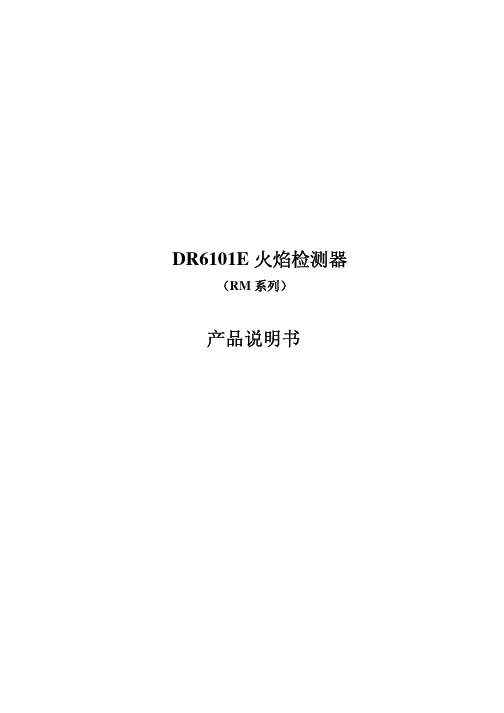
DR6101E火焰检测器(RM系列)产品说明书IDD-II和IDD-IIU型火检探头1. 概述IDD-II/IDD-IIU型火检探头是一种经制造厂封装的装置, 属不可修理部件,它根据被观察燃烧器燃烧火焰的强度和频率的不同,产生与之成正比的交流信号,随后将信号通过四芯电缆传送至放大器。
IDD-II火检探头的主要部件是一个铁制盒,内含硫化铅(PbS)传感器和一个小印刷线路板,印刷线路板用于提供电源,并对PbS传感器产生的信号进行放大。
为简化结构和成本,采用PbS传感器窗口方式来替代透镜组件,整个组件用环氧树脂封装。
1.1 机械技术要求尺寸:1.75 x 6.25 英寸重量:1 磅5盎司安装螺纹:1.00” NPT符合NEMA4标准观察角度(非限制性的):120°建议的观察角度:3-5°运行温度:0°- +140℉ 运行-25°- +140℉ 储藏冷却/密封风要求:10 scfm, 6.00” W.C.光谱响应:IDD-II (38321-01):700 – 3300 nmIDD-IIU(38321-02):400 – 3300 nm1.2 电气要求:输入电压:传感器偏置电压:+50 vdc,逻辑电压:+12 vdc。
输出电压:0.1 – 8.0 vac.耗电: 最大0.12 vA电缆: 四芯屏蔽电缆, 20 线规多股绞合线最大电缆长度(火检至放大器的距离): 1320 英尺接头(闷头):MS3112E10-6P接头(电缆):MS3116E10-6S2. 安全性注意事项:安装和拆除IDD-II/IIU探头时,应带上安全眼镜以防冷却风/密封风中的悬浮颗粒或因风箱气体背压而导致眼睛伤害。
3、安装IDD-II/IIU探头通常的安装方式有两种:“前墙安装”或者是直接瞄准安装,当直接瞄准安装有困难的时候可使用光纤来瞄准。
通常FORNEY公司会根据具体项目的需要,随火检探头一起发运某些安装火检的设备。
石油勘探设备使用说明书

石油勘探设备使用说明书使用说明书一、前言本使用说明书适用于石油勘探设备。
为了确保设备的正常运行和使用,本手册将详细介绍设备的操作方法、使用注意事项以及常见问题解决方法。
二、设备概述石油勘探设备是一种专用设备,主要用于石油勘探过程中的测量、取样和分析等工作。
设备由以下主要部件组成:1. 主机:包括控制系统、传感器、数据采集器等,主要负责设备的控制和数据采集。
2. 附件:包括石油钻探工具、测量仪器和样品容器等,用于辅助完成勘探任务。
三、设备使用方法1. 准备工作(1)确保设备完好。
在使用设备之前,需检查设备的各部件是否完好,如有损坏或故障应及时修复或更换。
(2)设备连接。
将主机和附件按照相应接口连接,确保连接牢固。
(3)供电。
连接电源并确保供电正常。
2. 设备操作(1)开机。
按下电源按钮,设备将开始启动。
(2)设备校准。
根据设备提示,进行设备校准操作。
(3)功能选择。
根据实际需求,选择相应的测量、取样或分析功能。
(4)数据采集。
启动数据采集功能,设备将自动采集相关数据,并在屏幕上显示。
3. 设备维护(1)定期清洁。
使用设备一段时间后,需要对设备及附件进行清洁,以保持设备的正常操作。
(2)注意防护。
在操作设备时,需佩戴相应的防护装置,如眼镜、手套等,以确保人身安全。
(3)故障排除。
如设备出现故障或异常情况,应立即停止使用,并按照设备维修手册进行故障排除。
四、注意事项1. 使用环境。
设备适用于石油勘探工作,在使用过程中应避免使用于非规定环境,以免影响设备的正常运行。
2. 操作人员。
使用设备应由经过培训、熟悉设备操作方法的人员操作,以确保设备的准确使用和安全性能。
3. 避免过载。
在使用设备时,应根据设备的额定参数确定使用范围,并避免超过设备的最大负荷。
4. 定期检查。
建议对设备进行定期检查和维护,发现问题及时解决,以确保设备的长时间稳定运行。
五、常见问题解决方法1. 设备无法正常启动可能原因:设备供电异常或设备损坏。
火焰检测探头冷却风系统说明书-中文
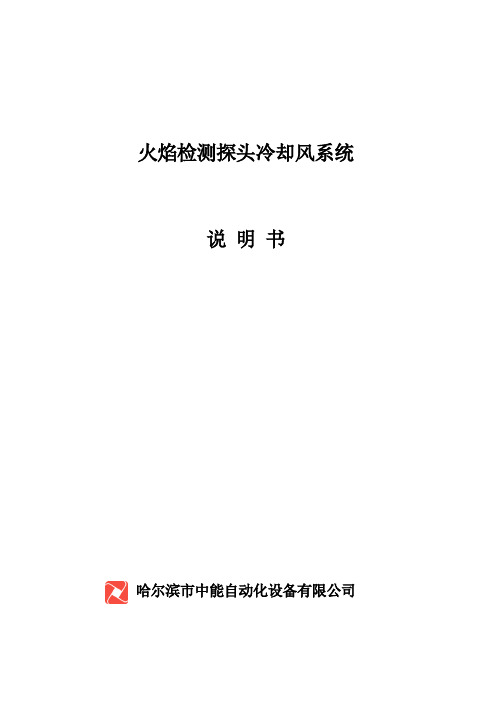
火焰检测探头冷却风系统说明书哈尔滨市中能自动化设备有限公司1、用途:火焰检测装置是电站锅炉等大型燃烧设备炉膛安全监控系统(FSSS)的关键设备。
火焰检测探头冷却风系统是其中一个重要部分,只有保证冷却风质量才能保证火焰检测效果及火检探头的寿命。
本系统的基本功能是冷却及清洁火焰检测探头,保证其在锅炉内最佳检测点安全可靠地运行。
2、主要技术参数及选型参考2.1主要技术参数见表12.2选型时应根据火检探头型式、数量(Z)、风量(Q=D╳q╳z,k-余量系数,一般可取1.1~1.3,q-每个探头的需风量,一般取1.0m3/min,z-探头数量),布置形式等组成通风管网系统,然后进行系统空气动力计算,得出风阻特性曲线。
根据高压离心通风机性能曲线得出最佳工作点,从而确定风机及所需冷却风系统型号。
2.3冷却风系统保证在不同工况下运行的火检探头的入口风压比炉膛压力高出一定的整定值,以使维持每个探头导管的风量至少为每分钟1.0立方米。
管路测点对炉膛差压开关的设定值为2000 Pa,低于此值延时5秒钟后应报警,同时启动另一台风机。
测点位置见附图。
图1 压力测点示意图2.4过滤器进出口设置差压开关,用以做为判断过滤网堵塞报警开关。
判断堵塞的差压开高于400pa时,应报警,提示运行人员去清洗滤网。
3主要组成部分及结构特征3.1冷却风系统主要由冷却风机、空气过滤器、转换档板、差压开关及冷却风就地控制柜等组成。
来自外界或送风机出口的空气经两路并联过滤器的过滤,送至两台并联的冷却风机入口,冷却风机将空气变为高压风送入三通路的换向挡板,再由一个总出口进入管网,两台风机互为100%备用,任一台均能满足所有探头的冷却风要求。
3.2在探头冷却风机附近设有风机控制箱,负责风机的控制,其控制方式应遥控\就地手操兼容,控制箱上有风机的状态显示,箱体为悬挂防雨结构。
3.3风机控制柜所需电源要求两路供电,采用一控二方式,电源取自AC380V母线两个半段母线上。
Fireye火焰检测器95系列说明书
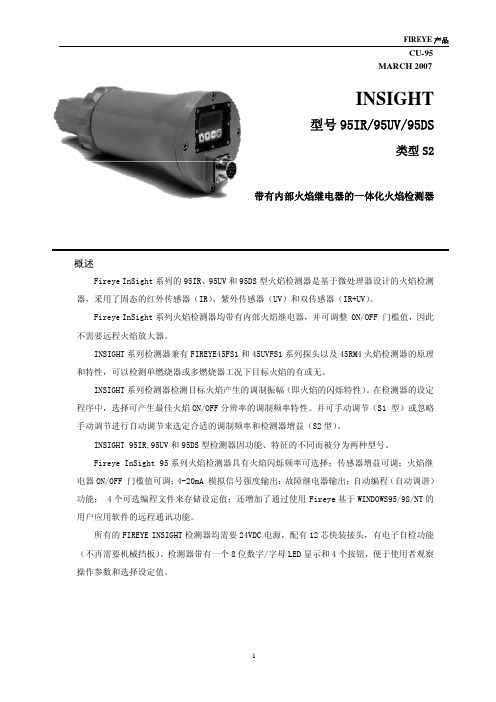
INSIGHT 95IR,95UV 和 95DS 型检测器因功能、特征的不同而被分为两种型号。 Fireye InSight 95 系列火焰检测器具有火焰闪烁频率可选择;传感器增益可调;火焰继 电器 ON/OFF 门槛值可调;4-20mA 模拟信号强度输出;故障继电器输出;自动编程(自动调谐) 功能; 4 个可选编程文件来存储设定值;还增加了通过使用 Fireye 基于 WINDOWS95/98/NT 的 用户应用软件的远程通讯功能。 所有的 FIREYE INSIGHT 检测器均需要 24VDC 电源,配有 12 芯快装接头,有电子自检功能 (不再需要机械挡板)。检测器带有一个 8 位数字/字母 LED 显示和 4 个按钮,便于使用者观察 操作参数和选择设定值。
1
FIREYE 产品
目录
INSIGHT......................................................................................................................................... 1 概述....................................................................................................................................................... 1 目录...........
食用油品质检测仪说明书
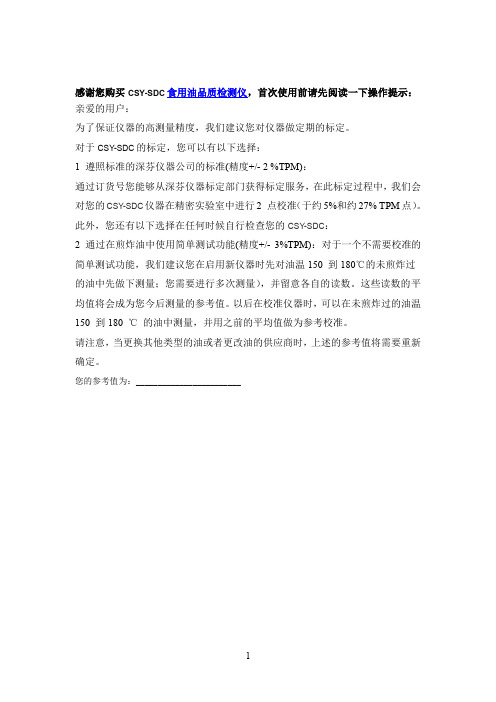
感谢您购买CSY-SDC食用油品质检测仪,首次使用前请先阅读一下操作提示:亲爱的用户:为了保证仪器的高测量精度,我们建议您对仪器做定期的标定。
对于CSY-SDC的标定,您可以有以下选择:1 遵照标准的深芬仪器公司的标准(精度+/-2 %TPM):通过订货号您能够从深芬仪器标定部门获得标定服务,在此标定过程中,我们会对您的CSY-SDC仪器在精密实验室中进行2 点校准(于约5%和约27% TPM点)。
此外,您还有以下选择在任何时候自行检查您的CSY-SDC:2 通过在煎炸油中使用简单测试功能(精度+/- 3%TPM):对于一个不需要校准的简单测试功能,我们建议您在启用新仪器时先对油温150 到180℃的未煎炸过的油中先做下测量;您需要进行多次测量),并留意各自的读数。
这些读数的平均值将会成为您今后测量的参考值。
以后在校准仪器时,可以在未煎炸过的油温150 到180 ℃的油中测量,并用之前的平均值做为参考校准。
请注意,当更换其他类型的油或者更改油的供应商时,上述的参考值将需要重新确定。
您的参考值为:________________________目录1 安全和环境.............................. ............. ............. ............. ............. ............. . (3)1.1. 关于此文件......................... ..................... ..................... ..................... (3)1.2. 安全需知........................ .............. .............. .............. .............. .............. .. (3)1.3. 环境保护.......................... ..................... ..................... ..................... (3)2 详细规格............................... ............................... ............................... . (3)2.1. 使用................................. ........................... ........................... ........................... .32.2. 技术参数......... ..................... ........................... ........................... .. (4)3 产品描述.............................. ..... ........................... ........................... . (4)3.1. 概述............................... ... ..... ........................... ........................... (4)3.2. 显示符号........................... ..... ........................... ........................... (6)3.3. 基本附件........................... ..... ........................... ........................... (9)4 初始操作.............................. . ..... ........................... ........................... .. (9)4.1. 试运行............................ .. . ..... ........................... ........................... . (9)4.2. 仪器的功能介绍...................... . ........................... ........................... (9)4. 2 . 1 . 开/关仪器................... . ..... ........................... ........................... . (9)4.2.2.LED警报. ................... . ..... ........................... ............................. .. (10)4.2.3.电池容量........................ . . ..... ........................... ........................... (10)4.2.4. 读数手动保持功能................. . ........................... ........................... (10)4.2.5. 读数自动保持功能................ . . ........................... ........................... ......... . (10)4.2.6. 自动关闭功能.............. .. . ..... ........................... ........................... .. (10)4.2.7. 设置TPM 极限值....................... ....................... ....................... .. (10)4.2.8.锁定/ 解锁T P M 极限值....................... ....................... ........ (11)4.2.9. 仪器的配置....................... ....................... ....................... ....................... . (12)4.2.10. 锁定/解锁配置模式... ................... ... ................... ... ................... ... (15)5 测量.................. ... .................. ... .................. ... .................. ... .................. ... . (15)5. 1 . 测量知识.......... ... ................ .......... ... ................ .......... ... ................ .......... .15 5.2. 执行测量.......... ... ............ .......... ... ............ .......... ... ............ .......... ... .. (16)5.3. 仪器功能自测...... .......... ... ........ ...... .......... ... ........ ...... .......... ... ........ ...... ..176 仪器的维护..... ... ........ ...... ..... ... ........ ...... ......... ..... ... ........ ...... ......... ..... ... ..18 6.1. 更换电池.......................... .......................... .......................... .......................... ..18 6 . 2 . 清洗探头...................... ...................... ...................... ...................... (18)6. 3 . 清洗外壳...................... ...................... ...................... ...................... . (18)6.4. 标定/校准仪器.................... ........... .................... ........... .................... ........... ..187 常见问题和回答................ ........... ...... ................ ........... ...... ................ (18)1 安全和环境1.1. 关于此文件使用> 请在使用本产品前仔细阅读本文件并保证您已熟悉本产品的使用,尤其注意安全指导和警告提示预防在使用过程中造成伤害和对仪器的损坏。
SharpEye UV IR 火焰检测器 20 20L及20 20LB说明书
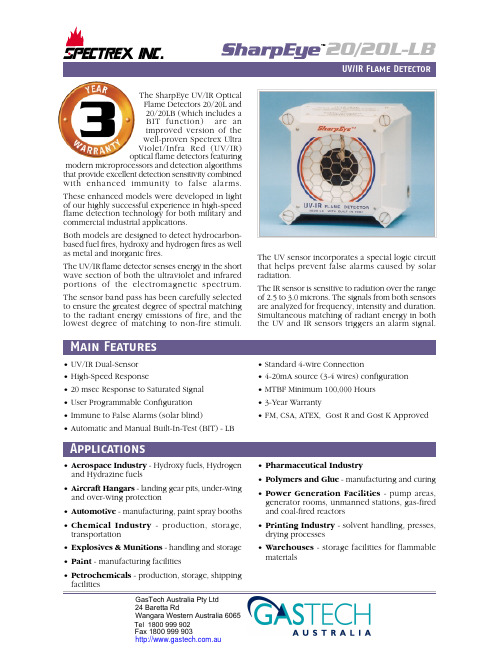
The SharpEye UV/IR Optical Flame Detectors 20/20L and 20/20LB (which includes a BIT function) are an improved version of the well-proven Spectrex Ultra Violet/Infra Red (UV/IR)optical flame detectors featuringmodern microprocessors and detection algorithms that provide excellent detection sensitivity combined with enhanced immunity to false alarms.These enhanced models were developed in light of our highly successful experience in high-speed flame detection technology for both military and commercial industrial applications.Both models are designed to detect hydrocarbon-based fuel fires, hydroxy and hydrogen fires as well as metal and inorganic fires.The UV/IR flame detector senses energy in the short wave section of both the ultraviolet and infrared portions of the electromagnetic spectrum.The sensor band pass has been carefully selected to ensure the greatest degree of spectral matching to the radiant energy emissions of fire, and the lowest degree of matching to non-fire stimuli.The UV sensor incorporates a special logic circuit that helps prevent false alarms caused by solar radiation.The IR sensor is sensitive to radiation over the range of 2.5 to 3.0 microns. The signals from both sensors are analyzed for frequency, intensity and duration.Simultaneous matching of radiant energy in both the UV and IR sensors triggers an alarm signal.• UV/IR Dual-Sensor • High-Speed Response• 20 msec Response to Saturated Signal • User Programmable Configuration • Immune to False Alarms (solar blind)• Automatic and Manual Built-In-Test (BIT) - LB• Standard 4-wire Connection• 4-20mA source (3-4 wires) configuration • MTBF Minimum 100,000 Hours • 3-Year Warranty• FM, CSA, ATEX, Gost R and Gost K Approved•Aerospace Industry - Hydroxy fuels, Hydrogen and Hydrazine fuels•Aircraft Hangars - landing gear pits, under-wing and over-wing protection•Automotive - manufacturing, paint spray booths •Chemical Industry - production, storage,transportation•Explosives & Munitions - handling and storage •Paint - manufacturing facilities•Petrochemicals - production, storage, shipping facilities•Pharmaceutical Industry•Polymers and Glue - manufacturing and curing •Power Generation Facilities - pump areas,generator rooms, unmanned stations, gas-fired and coal-fired reactors•Printing Industry - solvent handling, presses,drying processes•Warehouses - storage facilities for flammable materialsApplicationsTel 1800 999 902Fax 1800 999 903GasTech Australia Pty Ltd Wangara Western Australia 606524 Baretta Rd.auSpecifications subject to changesDS-F-UV/IR, May 2005Relays Alarm - 2A at 30 VDC, 0.5A at 250 VAC Fault and Accessory - 5A at 30 VDC and 250 VAC Fault relay normally closed, others normally open 4-20mASource configurationFault: 0 +0.5mA BIT Fault: 2mA ±10%Normal: 4mA ±5%IR Detection:8mA ±5%UV Detection:12mA ±5%Warning:16mA ±5%Alarm:20mA ±5%Resistance Loop: 100-600 ΩPower SupplyOperating Voltage: 18-32 VDC Power Consumption Max. 100mA in stand-by Max. 150mA in alarm Electrical Connection2 x 3/4" - 14NPT conduits or 2 x M25 x 1.5 mm ISO Electrical Input ProtectionAccording to MIL-STD-1275A Electromagnetic CompatibilityEMI/RFI protected CE MarkedSpectral Response Detection RangeResponse TimeAdjustable Time Delay Field of View Built-in-TestTemperature Range Humidity UV: 0.185 - 0.260 microns.IR: 2.5 - 3 microns.Gasoline 50 ft (15m)Methanol 25 ft (7.5m)n-Heptane 50 ft (15m)Methane* 16.5 ft (5m)Diesel Fuel 37 ft (11m)LPG (Propane)* 16.5 ft (5m)JP5 37 ft (11m)Hydrogen* 16.5 ft (5m)Kerosene 37 ft (11m)Silane*** 16.5 ft (5m)Alcohol (Ethanol) 25 ft (7.5m)Polypropylene Pellets** 16.5 ft (5m)IPA (Isopropyl Alcohol) 25 ft (7.5m)Office Paper 12 ft (4m)*20" (0.5m) plume fire, **8" (0.2m) Diameter, ***12" (0.3m) plume fireTypical 5 sec.Up to 30 sec. (up to 20 sec. in compliance with FM requirements)90° horizontal, 90° verticalManual and Automatic BIT (in model 20/20LB only)Operating:-40°F (-40°C) to 160°F (70°C)Operating Option: -40°F (-40°C) to 185°F (85°C)Storage:-65°F (-55°C) to 185°F (85°C)Up to 95%Dimensions 4.7" x 5.2" x 5.2" (120 x 132 x 132 mm)Weight Aluminum: 8.1Lb (3.7 Kg)St.St 316L: 14.3Lb (6.5 Kg)EnclosureAluminum, heavy-duty copper free (less than 1%), white epoxy enamel finish.Optional - Stainless Steel 316L with electro polish finish.Environmental Standards Meets MIL-STD-810C for Humidity, Salt & Fog, Vibration, Mechanical Shock, High Temp, Low Temp Water and DustIP66 and IP67 per En60529NEMA 250 6P(Highest Sensitivity Setting for 1 ft 2 (0.1m 2) pan fire)Fire Simulator 20/20-311Swivel Mount20/20-003 (St. St. 316L)ATEX EX II 2G, EExd IIB + H 2 T5 (70°C), T4 (85°C)EX II 2G, EExde IIB + H 2 T5 (70°C)FM / CSA Class I Div. 1, Groups B, C & D Class II Div. 1, Groups E, F & G GOST R1ExdIIBT5/H 2。
火检传感器安装说明

安装说明
1.视野合适,便于维护和安装。
2.位置
○1观火位置要选在亮区,上面或侧面
○2主要参数
3.燃料燃烧的火焰闪烁频率:煤40~80HZ 油60~100HZ 4调试:反复进行
a 调gain 使flame “on”(正在燃烧)
b 使燃烧器off ,调背景
c 使燃烧器on ,调gain , 使flame “on”
5.确定火检安装位置的
根据“火球”的旋转方向,确定火检安装位置的大范围。
一般的,对于某一喷燃器所喷出的混合气流来说,得到的热量越多,燃烧起来就更容易、更充分,其亮度也就越大,反之,就越暗,越不充分。
一侧的混合气流率先燃烧起来,且燃烧的充分程度也远大于另一侧。
一般的,靠近热源方向一侧为亮区,另一侧为暗区。
结论:(1)火检安装位置要尽可能在亮区,及靠近热源一侧。
(2)火检安装应在火焰的上部或侧上面。
火焰检测器使用说明

HJ10火焰检测器HJ10火焰检测器体积小、重量轻,采用八脚继电器安装形式,安装方便、快捷,适用于需要密集火检的场合。
具有性能优良、灵敏度高,工作稳定可靠等特点,可以实现火焰检测,熄火保护等功能,广泛应用燃气、燃油系统需要火焰检控的场合,是安全用气(油)的必备仪表。
一、原理框图传感器信号经信号处理电路处理,送比较电路进行判别,将结果送至输出电路,输出并指示。
1、着火响应时间:≤0.5秒2、熄火响应时间:0.5 ~ 5秒可调3、输出方式:继电器触点(无源)1A4、外形尺寸:48×48×100mm 开孔尺寸:45×45mm三、接线及紫外光敏管总成:仪表不带紫外光敏管总成,用户需要另购。
紫外光敏管总成的两根引出线不能短路或漏电,若短路或漏电会烧坏仪表及光敏管。
紫外光敏管前端与燃烧器连接管应有冷风吹扫,以降低紫外光敏管的温度,减少灰尘蒙在透紫玻璃上,延长光敏管的使用寿命。
若火焰较大,请加长光敏管总成与燃烧器的连接管。
JH02—A2火焰检测器JH02—A2火焰检测器系本公司JH02—A型火焰检测器的更新换代产品,其传感器为探棒式(离子棒)。
更新换代后的火焰检测器体积比原来的要小,结构紧凑、外形美观、检测可靠,按装使用方便,并且可以仪表面板式(按装在仪表屏上)和继电器二用(按装于仪表箱内),特别适用需要密集火焰检测的场合。
JH02—A2火焰检测器不但有火焰指示,而且有一组常开、常闭触点输出,供用户扩展使用。
一、主要技术指标1、着火响应时间:≤0.5秒2、熄火响应时间:0.5~5秒可调3、输出方式:继电器触点(无源)3A4、面板尺寸:52×104(竖式,宽×高)5、开孔尺寸:46×78(用于面板式按装)6、外形尺寸:52×104×118(连8脚插座)二、按装与使用1、按仪表面板及继电器座子上表示的正确接线。
(继电器座子见图一)2、“探棒”要接触火焰,“探棒地”一定要可靠接地(如不接地会检不到火),若火焰喷射时,由于燃烧介质压力引起火焰脱离管道口,则应用耐高温的金属材料将火焰尾部与管道连接起来,以保证火检的正确性。
火焰检测器使用手册说明书
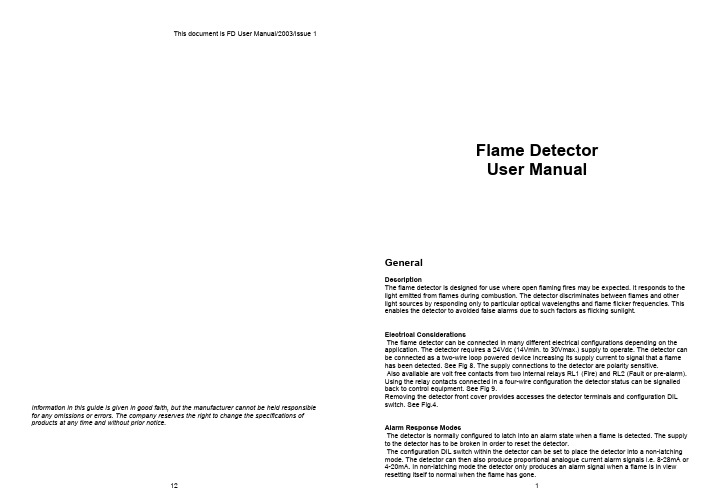
This document is FD User Manual/2003/Issue 1Flame DetectorUser ManualGeneralDescriptionThe flame detector is designed for use where open flaming fires may be expected. It responds to thelight emitted from flames during combustion. The detector discriminates between flames and otherlight sources by responding only to particular optical wavelengths and flame flicker frequencies. Thisenables the detector to avoided false alarms due to such factors as flicking sunlight.Electrical ConsiderationsThe flame detector can be connected in many different electrical configurations depending on theapplication. The detector requires a 24Vdc (14Vmin. to 30Vmax.) supply to operate. The detector canbe connected as a two-wire loop powered device increasing its supply current to signal that a flamehas been detected. See Fig 8. The supply connections to the detector are polarity sensitive.Also available are volt free contacts from two internal relays RL1 (Fire) and RL2 (Fault or pre-alarm).Using the relay contacts connected in a four-wire configuration the detector status can be signalledback to control equipment. See Fig 9.Removing the detector front cover provides accesses the detector terminals and configuration DILswitch. See Fig.4.Information in this guide is given in good faith, but the manufacturer cannot be held responsiblefor any omissions or errors. The company reserves the right to change the specifications ofproducts at any time and without prior notice.Alarm Response ModesThe detector is normally configured to latch into an alarm state when a flame is detected. The supplyto the detector has to be broken in order to reset the detector.The configuration DIL switch within the detector can be set to place the detector into a non-latchingmode. The detector can then also produce proportional analogue current alarm signals i.e. 8-28mA or4-20mA. In non-latching mode the detector only produces an alarm signal when a flame is in viewresetting itself to normal when the flame has gone.• • • • • • • Application for Flame DetectorsFlame detectors are used when detection is required to be:Unaffected by convection currents, draughts or wind Tolerant of fumes, vapours, dust and mist Responsive to a flame more than 25m away Fast reactingThe detector is capable of detecting the optical radiation emitted by burning material even non-carbonaceous materials. e.g. HydrogenNumerous other potential fire sources can be detected such asLiquids Solids Gases ● Aviation Fuels (kerosene) ● Coal ● Butane ● Ethanol ● Cotton ● Fluorine ● Methylated Spirits ● Grain & Feeds ● Hydrogen ● n-Heptane ● Paper ● Natural Gas ● Paraffin ● Refuse ● Off Gas ● Petrol (gasoline) ● Wood ● PropaneTypical applications examples are:● Agriculture ● Coal handling plant ● Pharmaceutical ● Aircraft hangars ● Engine rooms ● Power plants ● Atria ● Generator rooms ● Textiles ● Automotive industry ● Metal fabrication ● Transformer stations - spray booths ● Paper manufacture ● Waste handling - parts manufacture ● Petrochemical ● WoodworkingApplications and Locations to Avoid:● ambient temperatures above 55°C ● large IR sources – heaters, burners, flares ● close proximity to RF sources ● obstructions to field of view ● exposure to severe rain and ice ● sunlight falling directly on the detector optics ● large amounts of flickering reflections ● spot lighting directly on the detector opticsQuantities Required and Positioning of DetectorsThe number of detectors required and their position depends on:the anticipated size of the flamethe distance of the flame from the detector the angle of view of the flame detectorThe flame detector is designed to have a class 1 performance as defined in BS EN54-10:2002 on the high sensitivity setting. That is the ability to detect an n-heptane (yellow) fire of 0.1m² or methylated spirit (clear) fire of 0.25m² at a distance of up to 25m within 30 seconds.The detector can be set to have to a lower sensitivity setting equivalent to class 3 performance. Class 3 performance is defined as detecting the same size fires as for class 1 but at a distance of only 12m.Functional TestingWhen 24Vdc power is applied to the detector the green supply on indicator LED will illuminate. The fault relay RL2, if selected with the DIL switch, will energise and the contact between terminals 7 and 8 will close. If 24Vdc is applied to terminals 3 and 4 or terminal 3 is linked to terminal 1 the detector will perform a self-test. It does this by causing internal optical test sources to simulate the behaviour of flames and the detector will alarm. Alternatively a portable flame sensor test unit is available to generate simulated flame behaviour and test the detector a few metres in front of the detector. See Fig 12.Finally, provided it is safe to do so, carry out a flame test using a flickering flame source, such as a portable Bunsen burner. See Fig 13.A still non-flickering flame will not produce a response from the detector.Fig 12 Portable Flame Detector Test Unit Fig 13 Portable Bunsen BurnerService & RepairsServicing of the fire protection system should be carried out by competent persons familiar with this type of system, or as recommended by the local regulations in force. Only the manufacturer or equivalent authorised body may carry out repairs to the flame detectors. In practical terms this means that flame detector may be repaired only at the manufacturers factory.Fig 9 4 Wire Connection DiagramThe circuit shown above enables the flame detectors to interface with most type of fire alarm control systems. The fire relay RL1 is used to switch the required alarm load ‘R’ to generate a fire alarm signal. An end of line device ‘EOL’ mounted in the last detector provides the system with the ability to monitor the detector fault relay RL2 and the integrity of the interconnecting cables.InstallationIt is important that the detectors are installed in such a way that all terminals and connections are protected to at least IP20 with the detector cover fitted. The earth bonding terminals are provided for convenience where continuity of a cable sheath or similar if required.Adjustable mounting brackets and weather shields are available as shown below.Fig 10 Stainless Steel Adjustable MountFig 11 Stainless Steel Weather ShieldIn fact, the flame detector will detect fires at distances of up to 40 metres, but the flame size at such distances needs to be proportionally greater in order to be sure of reliable detection. Thus the yellow flickering flame that can be detected at 25m, provided that its size is not less than 0.1m², will have to be 0.4m² in order to be detected at 40metres.In a rectangular room the distance from the flame detector to the fire is calculated by the formula:Maximum distance = √ L² + W² + H²In the example shown in fig 1 the room in which the flame detector is to be installed measures 20m x 10m x 5m; the maximum distance from the detector to the flame will therefore be;Fig 1 Calculation of distance from detector to flameField of ViewThe flame detector has a field of view of approximately 90°, as shown in the diagram below.Fig 2 Conical field of view of the flame detectorFig 3 Detector Field of View PlotThe flame detector should be positioned at the perimeter of the room, pointing directly at theanticipated flame or at the centre of the area to be protected. If the detector cannot ‘see’ the whole of the area to be protected, one or more additional detectors may be required.The flame detector is not affected by normal light sources but should be positioned so that sunlight does not fall directly onto the viewing window.Detector Window ContaminationIt is important to keep the detector window clean and checks should be carried out at regular intervals – determine locally according to the type and degree of contamination encountered – to ensure optimal performance of the flame detector. Although the IR detectors can detect flames when the window is contaminated, there may be a reduction of sensitivity as shown in Table 1.Contamination Typical percentage of normal responseWater spray75%Steam 75%Smoke 75%Oil film 86% Salt water film 86% Dry salt deposits86%Table 1 IR Detector window contaminationUV/IR detectors are more susceptible to window contamination and must be kept clean.Connection Information-90°90°DetectorFig 8 Basic 2 Wire Connection DiagramThe simplest method of connecting the flame detector is in a 2-wire configuration as shown above. With a 24Vdc supply the current (i ) drawn by a detector/detectors can be monitored to determine the detector status. The DIL switches within the detector can be set to produce different current values (i ) to suit control systems.Detector Supply Currenti @ 24Vdc DIL Switch SettingNormal Quiescent Current Alarm (Fire) Current 1 2 3 4 Comment3mA 9mA 0 0 0 0 Lowest power configuration, RL1 only 4mA 20mA 0 0 1 0 For 4-20mA systems, no relays 8mA 14mA 1 1 1 0 Lowest power configuration & relays 8mA 20mA111For 4-20mA systems & relays 8mA28mA 1111Fire control panelsTable 4 Detector Supply & Alarm CurrentsIf the detector supply current falls below the normal quiescent current consumption then a fault is present. This could be simply an open circuit cable fault or a fault within the detector possibly due to the detector being taken over its rated temperature.Detectors can be connected in parallel increasing the overall quiescent current required. The alarm current signal will remain the same with the additional quiescent current drawn from other detectors.21Control Unit(Supplied by others)Flame Detector Single pair cable, also see note 1i++24Vdc Normal(Break supply to reset if detector set to latch)--NOTE 1Screened cable should be used with one end of the screen connected to earth. Also care should be taken not to run the detector cable next to power cables.Theory of OperationThe detector responds to low-frequency (1 to 15 Hz.) flickering IR radiation emitted from flames during combustion. IR flame flicker techniques enable the sensor to operate through a layer of oil, dust, water vapour, or ice.Most IR flame sensors respond to 4.3µm light emitted by hydrocarbon flames. By responding to 1.0 to 2.7µm light emitted by every fire all flickering flames can be detected. Gas fires not visible to the naked eye e.g. hydrogen may also be detected. The dual (IR²) and triple (IR³) IR photoelectric detectors, responding to neighbouring IR wavelengths, enable it to discriminate between flames and spurious sources of IR radiation. The combination of filters and signal processing allows the sensor to be used with little risk of false alarms in difficult situations characterised by factors such as flickering sunlight.Signal ProcessingThe detector views the flame at particular optical wavelengths. The more differing optical wavelength signals available the better the detector is at discriminating between flames and false optical sources. So although IR², IR³ and UV/IR² detectors can detect similar sized flames at the same distances, the UV/IR² detector willgive the greatest optical false signal immunity as it has the most diverse selection of optical wavelengths.The detector processes the optical signal information to determine if a flame is in view. This is achieved by comparing the signals with known flame characteristics stored within the detector.Fig 7 Block Diagram of the Detector Signal ProcessingIf the detector has interpreted the optical signals as a fire then it produces the required output responses. This will be in the form of supply current changes and the illumination of the red fire LED. The fire relay will also change state if required. The detector is constantly checking itself to ensure it is performing correctly. If a fault occurs the detector supply current will reduce, the fault relay will de-energise and the green supply LED will no longerilluminate constantly.FlameDetector InteriorFig 4 Detector with Front Cover removedElectrical ConnectionsThe flame detector has eight connection terminals as show in Fig 5. Removing the front cover of the flame detector accesses the connections. The cable is passed through the gland holes in the base of the detector.Fig 5 Electrical Connection TerminalsSupply ON (Green) - Steady if detector functioning correctly IR Optics -IR optical flame sensors & filtersFire (Red) - Indicates a FIRE detected Test (Yellow) - Indicates detector in test modeUV Optics (Option) -UV optical flame sensor if fittedDIL Switch -Select detector functionsConnection Terminals+IN -IN Test Input+R -RFLAME (N/O) Relay RL1FAULT (N/C) Relay RL2+24Vdc SupplyInputConnection Terminal DescriptionsTerminalNo. Mnemonic Function1 +IN Power Supply +V. +IN is the power supply input to the flame detectorand is normally 24Vdc with respect to terminal 2. The currentconsumption of detector can be monitored to determine the detectorstatus (Fault, Normal, Pre-alarm, Fire). If the detector is in latchingmode then this supply line must be broken in order to reset thedetector. A thermal fuse within the detector will blow and break the +INconnection if the detector operating temperature is exceeded.2 -IN Power Supply 0V. –IN is the return path for the detector supply current.-IN is also internally connected to terminal 4.3 +R Remote Detector Test Input +V. No connection to +R is necessary ifthe detector optical and circuit test feature is not required. If 24Vdc isapplied to terminals 3 and 4 the detector internal optical test sourceswill activate to simulate a flame. The detector yellow test LED willflicker to indicate an optical test is progress. The detector will thenalarm indicating that the test was successful.4 -R Remote Detector Test Input 0V. No connection to -R is necessary if thedetector optical and circuit test feature is not required.-R is internally connected to terminal 2.56 RL1Flame Relay RL1. This volt free contact is normally open (N/O) andonly closes when a flame has been detected. If the detector is inlatching mode (see DIL switch settings) the contact will remain closedonce a flame has been detected. Only when the detector supply +IN isbroken will the detector reset and the contact open once again. Thecontact can be changed to a normally closed (N/C) state by moving thelink on JP1 in the rear of the detector.Maximum relay contact ratings: Power=3W, Current=0.25Amp,Voltage=30Vdc. Resistive loads only.78 RL2Fault or Pre-alarm Relay RL2. This volt free contact is normally closed(N/C) if the detector has no faults and the supply voltage betweenterminals +IN and –IN is the correct value. If the detector mode ischanged (see DIL switch settings) this relay can be de-energised toreduce the detector current consumption. Alternatively RL2 can be setto provide a pre-alarm fire signal. The normal contact state can bechanged state by moving the link on JP2 in the rear of the detector.Maximum relay contact ratings: Power=3W, Current=0.25Amp,Voltage=30Vdc. Resistive loads only.Table 2 Connection Terminal Descriptions Selectable Detector Functions(DIL Switch Settings)Fig 6 DIL Switch with Detector Front Cover Removed (Normal factory settings shown)Selectable Functions DIL Switch Settings Relay RL2 Function: 1 2 RL2 off (No fault relay) – For lowest detector current consumption. 0 0 RL2 off, or UV pre-alarm, flame or electrical sparks detected. 1 0RL2 energised on IR pre-alarm0 1RL2 detector fault relay (Energised if detector powered and no faults) 1 ~ 1 Detector Supply Current (Detector Status): [-/ = see Output Mode below] 3 4 Low current mode, 3mA / 9mA (RL1 Only), 8mA / 14mA (RL1 & RL2) 0 0 Two-wire current signalling only. No relays operating. 4-20mA, 4/20mA 1 0 Two-wire current signalling 8-20mA, 8/20mA and both relays operating. 0 1 Two-wire current signalling 8/28mA and both relays operating. 1 ~ 1 Output Mode: 5(-) Proportional analogue supply current. Non-latching fire alarm signalling. (-) 0(/) Step change, supply current. Latching fire alarm signalling. (/) ~ 1 Response Time: 6 7Slowest ≈ 8s 0 0Medium ≈ 4s 1 ~ 0Fast ≈ 2s 0 1 Faster response times reduce the optical interference immunity. Very Fast ≈ 1s 1 1 Sensitivity: See EN 54-108Low Class 3 0High Class 1 ~ 1Factory settings ~Table 3 DIL Switch Settings。
图像火焰监视探头说明书
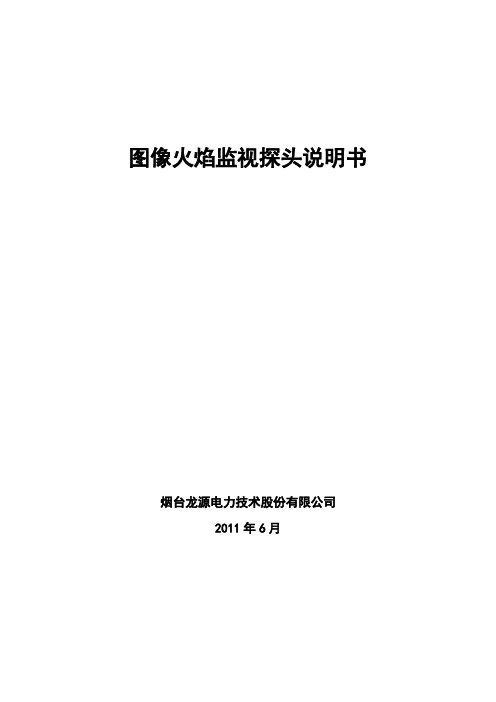
图像火焰监视探头说明书烟台龙源电力技术股份有限公司2011年6月目录安全注意事项 (2)第一章概述 (2)第二章结构及特点 (2)第三章技术参数 (3)第四章选型说明 (4)第五章安装说明 (4)5.1安装位置的确定原则 (4)5.1.1切圆燃烧锅炉 (4)5.1.2 墙式燃烧锅炉 (5)5.2二次风道内的探头安装 (5)5.3 观火孔上的探头安装 (5)5.4探头安装注意事项 (5)第六章常见故障及排除 (6)备件清单 (6)安全注意事项为防止探头烧损,在炉膛出口温度>45℃时,严禁停止探头冷却风!第一章概述图像火焰监视探头是利用火焰图像来全程监控炉内火焰燃烧状况,不受煤种和负荷变化影响的火焰监视装置。
其采用广角长焦距工作镜头和彩色CCD摄像机直接拍摄燃烧器火焰图像(视角为85°~90°),提供给操作人员可视化的真实燃烧图像信息。
锅炉运行人员根据燃烧器的火焰图像调整一次风和二次风的配比,提高煤粉的燃尽度和锅炉燃烧效率,减少烟气污染,从而使其达到监控燃烧,指导调控,保证锅炉运行在最佳状态,实现稳定、经济、洁净燃烧的目的。
第二章结构及特点图像火焰监视探头按特性分为挠杆和直杆两类。
图1为挠杆图像火焰监视探头结构图。
它主要由外套管、内套管、长工作距监测镜头等部件组成。
直杆图像火焰监视探头结构与挠杆图像火焰监视探头基本一样,两者区别仅在于外套管,一为直杆,一为挠杆。
图1 挠杆图像火焰监视探头结构图图像火焰监视探头的结构特点:●采用隔热机构,能有效地阻隔二次风传导热及炉膛高温辐射热对其影响。
●镜面采用特种耐温玻璃,能抗1500℃熔融灰渣对镜面的冲刷,保证镜面光滑无损。
●三通道及三组合弧形旋流冷却风喷射机构可使探头保持镜面清净并达到1200℃高温运行。
●内外套管采用哈夫夹环套结构,维修简单方便。
第三章技术参数●探头风阻特性:进口风压2000Pa时,冷却风量68Nm3/h。
●探头外径分别为Ф68mm(挠杆探头),Ф60mm(直杆探头)。
FD-11系列火检说明书
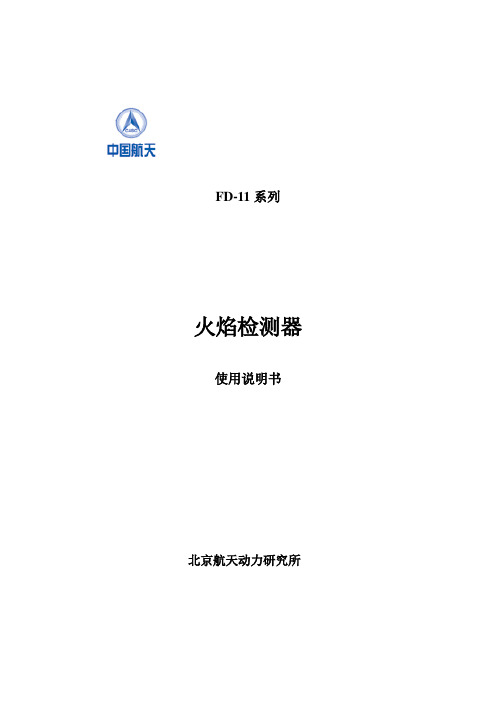
FD-11系列火焰检测器使用说明书北京航天动力研究所一、概述北京航天动力研究所,借助本研究所的技术力量,在吸收消化国内外先进技术的基础上,开发研制了FD-11系列火焰检测器。
FD-11b 是专为石化系统中加热装置研制的第二代产品。
它适用于检测石油、化工等系统中加热装置内的火焰状态,从而了解燃料的燃烧情况,是国内先进的安全检测产品。
它体积小、操作简单、安装维修方便,具有可靠性高、稳定性好、抗干扰能力强、使用寿命长等多种优点。
FD-11b完善了第一代产品的不足,具有更大的适应性,是石油、化工等燃烧系统中必备的检测仪表。
二、主要技术指标1、火焰检测灵敏度:稳定探测距离不大于1米;2、工作环境温度:-40℃~+55℃;3、相对湿度:85%(30℃时);4、有火响应时间:不大于1.0秒;5、熄火响应时间:根据用户需要确定;6、工作电源:AC100V±10%,50Hz;或 AC220V±10%,50Hz;7、继电器触点最大负荷:AC220V,50HZ, 2A;8、功率:不大于10W;9、重量:每台约1.5kg;10、控制盒安装位置:距传感器不大于20米。
三、工作原理火焰检测器由二次表及传感器组成。
传感器能敏感炉内火焰产生的紫外线,通过传感器的紫外光管将火焰信号变成电信号,由二次表将信号进行放大、处理、输出。
二次表内为用户提供了一对继电器触点(常开和常闭),可为用户作火焰指示或当炉内无火时,作报警联锁使用。
同时还具有作为火焰强度指示的0-20mA的电流输出。
四、使用与维护1、安装(1)要使紫外光管探头对准火焰,以保证有较好的探测灵敏度。
(2)确保探头表面不受污染。
(3)探头处连接冷却风。
探头安装尺寸见图1。
火焰检测器箱安装尺寸见图2。
2、接线火焰检测器箱内装有两台FD-11b仪表,下方有一排端子,其中5和8对应于箱内火检Ⅰ的一对常开触点;6和10对应火检Ⅱ的一对常开触点。
当传感器检测到有火时,触点闭合。
- 1、下载文档前请自行甄别文档内容的完整性,平台不提供额外的编辑、内容补充、找答案等附加服务。
- 2、"仅部分预览"的文档,不可在线预览部分如存在完整性等问题,可反馈申请退款(可完整预览的文档不适用该条件!)。
- 3、如文档侵犯您的权益,请联系客服反馈,我们会尽快为您处理(人工客服工作时间:9:00-18:30)。
4.2 火焰检测系统我厂用的火焰监示系统包括FORNEY 公司生产的DPD(数字剖面)火焰检测器和DP 7000 数字剖面放大器,4.2.1火焰检测器1)概述 FORNEY 公司生产的数字剖面火焰监测器(简称DPD 火检)可用于鉴别单燃烧器或多燃烧器燃烧环境中目标火焰的存在于否。
DPD 火焰检测器采用了微处理器技术和专用软件,对目标火焰的频率和振幅特性不断地进行监测。
每个火焰有其独特的剖面特性,就犹如“指纹”一样。
在“学习”模式下,DPD 火检对目标火焰交流信号的频谱进行实时分析以确定被监测火焰的类型(如:燃烧器有火、相邻燃烧器窜火、背景火焰、无火)以及火焰频谱的特定剖面形状;在“运行”模式下,火焰检测器则不断地将目标火焰信号与所学的剖面特性进行比较从而准确地判断火焰的状态。
2)特点:智能显示——用于快速设置、精确瞄准以及火焰信号显示。
八位持续滚动的LED 显示提供火检所有设定值和火焰状况的瞬时读数显示。
编程简单可靠按钮键盘可直接对火检进行编程和显示。
但是为了避免未经授权的参数改动,在火检的后盖板下面装有编程驱动”Program Enable”锁定按钮。
灵活的运行参数可选择火焰熄火响应时间(FFRT):2-6 秒可选择背景火焰熄火响应时间(BFRT):2-8 秒可选择有火信号延时:2-4 秒可选择华氏或摄氏温度显示适用于任何结构的燃烧器适用于低Nox、枪式、摆动式、棒式、环式、层燃式等结构的燃烧器。
适用于任何燃料Super-blue 型DPD 火焰检测器可适用于大多数燃料的火焰监测,而Classic 型DPD 火检适用于煤/油的火焰,我厂所用是Classic 型DPD 火检。
在摆动式燃烧器或者空间受限制的应用中可选用光纤光纤可穿过拥挤的燃烧器空间使火焰检测器实现远程安装。
串行通讯——对火焰参数进行直接、实时的监测和分析通过RS485 接口将参数上载/下载至计算机或其它智能设备。
24 伏直流工作电压3). 安装概述:⑴. 用转动安装接头和六角螺钉将DPD 火检安装好。
⑵. 通过扁电缆和火检电缆将火检与24 伏直流电源连接。
⑶. 通上电源。
经过12 秒左右的回路试验。
⑷. 按以下八个步骤对DPD 火检进行编程。
步骤1:按下盖板下面的Program Enable 按钮使火焰监测器置于编程菜单状态(Programming Menu)。
步骤2:编辑文件F 驱动自动增益控制向火检放大器发送脉冲信号使火焰继电器得电。
步骤3:根据燃料种类、燃烧器类型、以及其它运行参数生成一个文件步骤4:在燃烧器投运时对火焰检测器进行瞄准,通过使用瞄准AIM 功能来获得最佳的视线(此时LED 显示为最低值)步骤5:学习有火时的火焰信号步骤6:学习无火时的火焰信号步骤7:保存文件(包括组态和火焰的信号参数)步骤8:运行文件4). 分以下部分介绍⑴. 火焰检测器的应用⑵. 技术要求⑶. 机械安装⑷. 火焰检测器附件的使用⑸. 电气安装⑹. 火检电缆(P/N 9101647)⑺. 接地和屏蔽技术⑻. 远程通讯接线⑼. 远程文件选择开关⑽. DPD火检的编程⑾. 状态菜单和设定值菜单⑿. 初始启动⒀. 火焰文件参数的增加⒁. 运行、故障排除和维护⑴火焰检测器的应用DPD 火焰检测器是对火焰的三维特性进行分析,这些特性会受到燃料品种和燃烧器类型的影响。
气体燃料火焰(丙烷、甲烷、天然气)往往会产生大量的紫外线,而固态(煤粉)和液态(油)燃料燃烧的火焰会产生大量的红外线,而燃烧器的类型会影响火焰的闪动频率。
红外线火焰检测器会识别目标火焰中的红外线辐射,但不能看穿火焰去检测相邻或相对燃烧器的火焰;红外线火焰检测器能会监测到气体燃料目标火焰中的红外线辐射,但也会直接穿过气体火焰去采集相对燃烧器火焰中的红外线信号。
技术先进的DPD 火焰检测器对这些火焰变量进行分析,从而对火焰的有无作出可靠准确的判断。
超蓝DPD 火焰检测器上装有超蓝硅光电池,它对富含于气体火焰和油火焰/煤火焰中的辐射敏感,因为超蓝DPD 火焰检测器中还装有自动信号放大回路;经典DPD 火焰检测器中含有硫化铅光电池用于红外线的检测,最适于检测燃煤和燃油火焰。
⑵. 技术要求:安装:1”NPT 内螺纹安装接头,提供1”NPT 热绝缘短管包括安装法兰的外壳材料:压铸铝外壳,表面为黑色,有一定规律的纹路。
设计:安装法兰,带有吹扫风接头,有两个1/4-20 螺钉为清洁透镜时快速拆除火检电子线路时所用。
装运重量:2.4 磅(1.1 公斤)。
电气要求:电源:+24VDC,取自DP7000 放大器,或+24VDC(+10%,-15%)取自外部电源。
每个火焰检测器的额定电流为100mA。
连接:快装接头(提供)。
火检电缆:部件号9101647,最大长度:1000 英尺接线电缆:部件号随长度的不同而不同。
键盘/显示屏. 8 位数字字母LED 显示(滚动显示功能). 3 个按键. 塑料滤光软性键盘Program Enable (编程驱动) 按钮运行条件:温度范围:-20℃ - +65℃湿度: 0-95%相对湿度,非凝结吹扫风风源:清洁的环境所需的流量:3/8”螺纹外壳进口处流量为4SCFM(113L/min)或位于火焰检测器瞄准管1”三通处的流量为4 SCFM。
当工作温度接近温度上限时或使用不洁燃料时所需的流量可能达到15 SCFM(425L/min)。
⑶. 机械安装a. 当火焰检测器的视线与燃烧器中心线相交有一个轻微的角度(如5 度)且能看到最大量的主燃烧区域时可获得最佳效果,如图2 所示。
如果每个燃烧器只使用一个火焰检测器,则火焰检测器的视线同时也应与点火火焰相交。
b. 当使用不同的火检来检测主燃料火焰和点火火焰时,主燃料火焰检测器的视线应检测不到点火火焰。
c. 火焰检测器的视野应不受阻碍,对于如调风器叶片等障碍物应予以排除或切除,使这些障碍物不在视线范围内。
修整调风器叶片之前应与燃烧器制造商联系。
d. 应考虑到燃烧器二次风的转向问题(有些燃烧器的二次风顺时针方向旋转,而有些逆时针旋转)。
当燃烧风以足够的的旋转速度进入炉膛时会使点火火焰随旋转方向偏移,应将火检安装于点火器下游10 至30 度的位置,并使之靠近燃烧器喇叭口的边缘。
e. 满意的火检位置应能在所有风量和炉膛负荷的情况下,都能确保对主燃料火焰/点火火焰的检测。
f.火焰检测器的安装推荐使用转动接头,P/N 9101663。
将转动接头与燃烧器板上或燃烧器观察管上2”孔对中,并用三个六角螺钉固定(螺钉不随机提供),将观察管安装于转动接头上。
如果不使用转动接头,应将观察管的末端插入孔中,并调节适当的观察角后用点焊固定(焊接强度应适当,用于临时支撑安装的火检探头重量即可),观察管应稍稍向下倾斜安装以免垃圾和灰尘在管中聚集。
火焰检测器探头通过LED 显示的反馈信息来调整安装角度。
请参阅“DPD 火检编程”章节中的AIM(瞄准)功能。
g. 经运行测试并对AIM 功能的设定,证实已获得满意的瞄准角度后,拧紧转动安装接头圈上的六角螺钉使转动球固定。
h.为便于使用,火焰检测器探头应安装在观察管上以便读取LED 显示。
如果无法这样做,安装火检探头时应将快装接头面向下。
(LED 显示不受安装位置的限制)。
i. 由于DPD 火检采用了微处理器设计,必须使用所供的热绝缘短管使火检探头隔热。
j. 火检透镜必须保持清洁无污染(油、飞灰、烟灰、赃物),火检温度不得超过它的最高额定温度150℉(65℃)。
过高的温度会缩短火检的使用寿命。
从3/8”入口处或转动接头前“Y”型三通处连续不断地注入冷却风,可满足上述两个要求,。
当使用密封短管的时候,1”三通接口用于注入吹扫风,3/8”开孔堵住。
在所有的装置上使用密封接管(部件号9102849)是一个很好的做法,这样可以保证避免不必要的锅炉正压损坏火检透镜。
在通常使用清洁燃料且环境温度适中的情况下,4 SCFM(133L/min)的吹扫风流量一般已够,对于会产生大量飞灰或烟灰的燃料,或是环境较热的情况下,吹扫风的流量可能需要达到15 SCFM(425L/min),以保证火检的内部温度维持在规定范围内。
⑷. 火焰检测器附件的使用安装转动接头火检安装转动接头,部件号:7819567,用于火检安装后调整火检的视角。
孔板孔板用于限制目标火焰区域的视角范围,减少气流,维持空气滞留以提高灵敏度。
孔板是用孔板固定圈来固定于转动安装接头球内的。
可购买孔板套件,部件号为4201626304。
火检瞄准火焰区域的理想范围应为目标火焰前沿截面积为8-25 平方英寸(50-150cm2)处。
火焰前沿为燃烧空间中的一个区分未燃尽燃料和燃尽燃料区域的平面。
例如:如果一个直径为1/2”的孔板置于距探头透镜1 英尺的安装接头球中,而转动接头位于4 英尺深的燃烧器上,而且如果稳定火焰范围为燃烧器风箱外5 英尺,那么火焰前沿的目标区域为19.6 平方英尺。
注意:鉴别力与灵敏度之间存在着反向的关系。
热绝缘管热绝缘管用于阻断热量从观察管至火检探头的传输,同时也用于探头与大地之间的绝缘,并减少产生热量和噪音。
每个DPD 火检探头都配供一个热绝缘管。
带石英窗的密封短管当探头的连接管中需装联管节或密封时应装密封短管。
石英窗可防止炉膛压力、热气体/烟灰直接接触到探头污染透镜。
密封短管的尺寸为1”美国标准锥管螺纹(1”NPT)。
当使用密封短管时,在其下游处必需从1”三通接头处连接吹扫风(堵住火检上的3/8”开孔)。
⑸. 电气安装连接电缆连接电缆为火检探头的连接以及远程通讯提供了方便。
使用远程通讯时需运行串接布置中的两根通讯线,而不要直接运行返回火焰放大器的通讯线。
为了便于串接布置,FORNEY 提供了几种长度的接线电缆(10’、15’、20’和30’)。
电缆一端的插座与火检探头上的插头配用。
电缆的另一端有一个接线盒,内装一个有20 个端子的U 形接线端子排,其中8 个端子已与快装接头插座预接,其余的12 个端子用于连接探头至放大器的返回信号(24VDC、电源、快门、公共点、火焰信号、远程文件1、2 选择),以及与其它探头进行通讯用的两芯通讯电缆(22 AWG,#8451)连接。
端子排端采用了推动式隔离接线柱,用小螺丝起子或相似的工具压下接线柱旁边的槽打开接线端子后插入接线。
拿开起子固定接线。
接线柱适用于14 号以下的接线。
⑹. 火检电缆(部件号9101647)火检探头与放大器的连接所用的电缆芯数取决于探头使用的功能。
FORNEY 公司 6 芯电缆(部件号9101647)应使用于连接电缆至放大器之间,该电缆由4 根18 号线规导线和2 根22 号线规导线构成。
所有六根导线均封闭于聚酯屏蔽套中,电缆外壳材料Hypalon, 电缆外径为0.425”(最大)。
